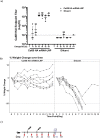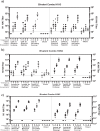Development of multivalent mRNA vaccine candidates for seasonal or pandemic influenza
- PMID: 34916519
- PMCID: PMC8677760
- DOI: 10.1038/s41541-021-00420-6
Development of multivalent mRNA vaccine candidates for seasonal or pandemic influenza
Abstract
Recent approval of mRNA vaccines for emergency use against COVID-19 is likely to promote rapid development of mRNA-based vaccines targeting a wide range of infectious diseases. Compared to conventional approaches, this vaccine modality promises comparable potency while substantially accelerating the pace of development and deployment of vaccine doses. Already demonstrated successfully for single antigen vaccines such as for COVID-19, this technology could be optimized for complex multi-antigen vaccines. Herein, utilizing multiple influenza antigens, we demonstrated the suitability of the mRNA therapeutic (MRT) platform for such applications. Seasonal influenza vaccines have three or four hemagglutinin (HA) antigens of different viral subtypes. In addition, influenza neuraminidase (NA), a tetrameric membrane protein, is identified as an antigen that has been linked to protective immunity against severe viral disease. We detail the efforts in optimizing formulations of influenza candidates that use unmodified mRNA encoding full-length HA or full-length NA encapsulated in lipid nanoparticles (LNPs). HA and NA mRNA-LNP formulations, either as monovalent or as multivalent vaccines, induced strong functional antibody and cellular responses in non-human primates and such antigen-specific antibody responses were associated with protective efficacy against viral challenge in mice.
© 2021. The Author(s).
Conflict of interest statement
The research is funded by Translate Bio, a Sanofi company and Sanofi Pasteur Inc. Sudha Chivukula, Timothy Tibbitts, Donghui Zhang, Natalie Anosova, Lu Li, Younghoon Kim, Heesik Yoon, Charles Lai, Sophia T Mundle, Yanhua Yan, Gregory Ulinski, Peter Piepenhagen, Victoria Landolfi, Joshua DiNapoli, Danilo Casimiro, Frank DeRosa, Ron Swearingen, Shrirang Karve, Rebecca Goldman, Ashish Sarode, Anusha Dias, Hardip Gopani, Asad Khanmohammed and Dustin Cooper are employees of Sanofi Pasteur or Translate Bio and may hold stock in the company.
Figures










References
-
- Shaw C, et al. 2754. Phase 1 Trial of an mRNA-based combination vaccine against hMPV and PIV3. Open Forum Infect. Dis. 2019;6(Supplement_2):S970–S970. doi: 10.1093/ofid/ofz360.2431. - DOI
-
- mRNA vaccines against H10N8 and H7N9 influenza viruses of pandemic potential are immunogenic and well tolerated in healthy adults in phase 1 randomized clinical trials. Vaccine37, 3326–3334. 10.1016/j.vaccine.2019.04.074 (2019). - PubMed
LinkOut - more resources
Full Text Sources
Other Literature Sources

